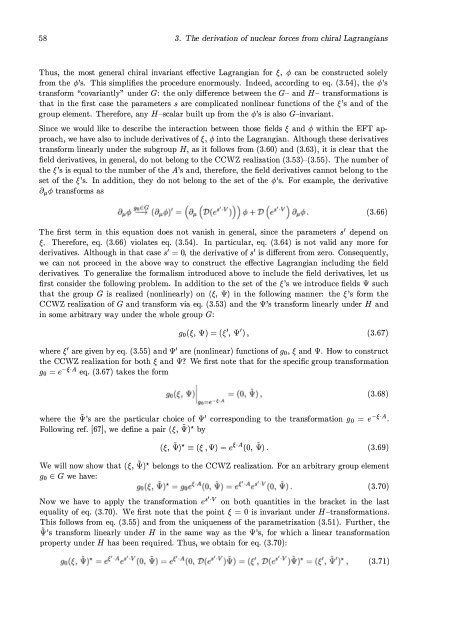The Nucleon-Nucleon Interaction in a Chiral Effective Field Theory
The Nucleon-Nucleon Interaction in a Chiral Effective Field Theory
The Nucleon-Nucleon Interaction in a Chiral Effective Field Theory
Create successful ePaper yourself
Turn your PDF publications into a flip-book with our unique Google optimized e-Paper software.
58 3. <strong>The</strong> derivation of nuclear forces from chiral Lagrangians<br />
Thus, the most general chiral <strong>in</strong>variant effective Lagrangian for �, cjJ can be constructed solely<br />
from the cjJ's. This simplifies the procedure enormously. Indeed, accord<strong>in</strong>g to eq. (3.54), the cjJ's<br />
transform "covariantly" under G: the only difference between the G- and H- transformations is<br />
that <strong>in</strong> the first case the parameters s are complicated nonl<strong>in</strong>ear functions of the ts and of the<br />
group element. <strong>The</strong>refore, any H-scalar built up from the cjJ's is also G-<strong>in</strong>variant.<br />
S<strong>in</strong>ce we would like to describe the <strong>in</strong>teraction between those fields � and cjJ with<strong>in</strong> the EFT approach,<br />
we have also to <strong>in</strong>clude derivatives of �, cjJ <strong>in</strong>to the Lagrangian. Although these derivatives<br />
transform l<strong>in</strong>early under the subgroup H, as it follows from (3.60) and (3.63), it is clear that the<br />
field derivatives, <strong>in</strong> general, do not belong to the CCWZ realization (3.53)-(3.55). <strong>The</strong> number of<br />
the ts is equal to the number of the A's and, therefore, the field derivatives cannot belong to the<br />
set of the ts. In addition, they do not belong to the set of the cjJ's. For example, the derivative<br />
0/lcjJ transforms as<br />
(3.66)<br />
<strong>The</strong> first term <strong>in</strong> this equation does not vanish <strong>in</strong> general, s<strong>in</strong>ce the parameters s ' depend on<br />
�. <strong>The</strong>refore, eq. (3.66) violates eq. (3.54). In particular, eq. (3.64) is not valid any more for<br />
derivatives. Although <strong>in</strong> that case s' = 0,<br />
the derivative of s ' is different from zero. Consequently,<br />
we can not proceed <strong>in</strong> the above way to construct the effective Lagrangian <strong>in</strong>clud<strong>in</strong>g the field<br />
derivatives. To generalize the formalism <strong>in</strong>troduced above to <strong>in</strong>clude the field derivatives, let us<br />
first consider the follow<strong>in</strong>g problem. In addition to the set of the ts we <strong>in</strong>troduce fields \)I such<br />
that the group G is realized (nonl<strong>in</strong>early) on (�, \)I) <strong>in</strong> the follow<strong>in</strong>g manner: the �'s form the<br />
CCWZ realization of G and transform via eq. (3.53) and the \)I's transform l<strong>in</strong>early under H and<br />
<strong>in</strong> some arbitrary way under the whole group G:<br />
go (�, \)I) = (t, \)I'), (3.67)<br />
where e are given by eq. (3.55) and \)I' are (nonl<strong>in</strong>ear) functions of go, � and \)I. How to construct<br />
the CCWZ realization for both � and \)I? We first note that for the specific group transformation<br />
go = e-f A eq. (3.67) takes the form<br />
(3.68)<br />
where the �'s are the particular choice of \)I' correspond<strong>in</strong>g to the transformation go = e-�·A .<br />
Follow<strong>in</strong>g ref. [67], we def<strong>in</strong>e a pair (�, �)* by<br />
- _ _ -<br />
(�, \)I) * = (� ,\)I) - e �·A (0, \)I) . (3.69)<br />
We will now show that (�, �)* belongs to the CCWZ realization. For an arbitrary group element<br />
go E G we have:<br />
(3.70)<br />
Now we have to apply the transformation eS'.v on both quantities <strong>in</strong> the bracket <strong>in</strong> the last<br />
equality of eq. (3.70). We first note that the po<strong>in</strong>t � = 0 is <strong>in</strong>variant und er H-transformations.<br />
This follows from eq. (3.55) and from the uniqueness of the parametrization (3.51). Further, the<br />
�'s transform l<strong>in</strong>early under H <strong>in</strong> the same way as the \)I's, for which a l<strong>in</strong>ear transformation<br />
property under H has been required. Thus, we obta<strong>in</strong> for eq. (3.70):<br />
(3.71)












